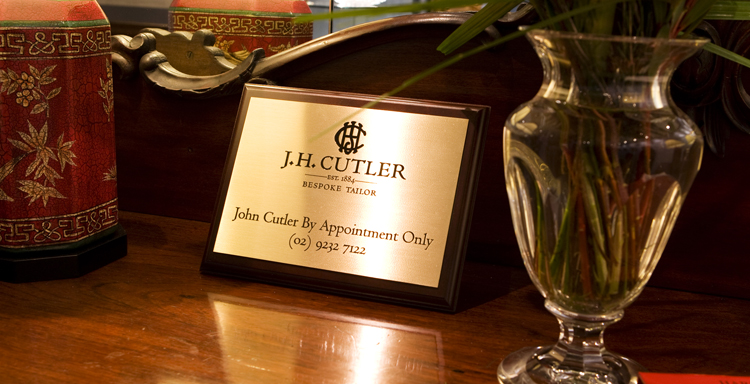Bespoke
Linguistically, “Bespoke” means nothing more than “ordered”, but in the upper echelons of tailoring, it takes on a world of additional meaning. It means the special cloth set aside for a future suit; it means the individually-crafted, perfectly fitting suit; it means a unique, even eclectic design, if that is what the customer wishes; it means 50 hours of labour, measuring, cutting, sewing and fitting; it means the long and leisurely conversations bringing the cloth, design and cut together; it means looking at one’s best without effort and it means years of wear and comfort.
Savile Row
Any story about bespoke tailoring begins in Savile Row in London, centre of bespoke tailoring since the 18th century. Anybody serious about bespoke tailoring starts there too. John Cutler started there, as his father and his grandfather did before him.
Arriving in London at the age of 18, John worked at Dormeuil Freres, one of the world’s foremost woollen houses and studied at the renowned Tailor & Cutter Academy. Savile Row still epitomises the old traditions and skills that made the street famous, and its graduates have carried these traditions and skills all over the world. But it is a thin field, and the calling is not for everyone, combining as it must exceptional skill, attention to detail, an ability to strike a rapport and discretion.
J H Cutler
The firm of J H Cutler in Sydney has been making suits for the leading people in Australia for generations, and John, as the fourth generation of the Cutler family to run the business, is discretion personified. A handcrafted suit takes time to create and evolves from a variety of traditional elements. Everything from yards of finest silk and cotton thread to horsehair stiffener, from canvas backing, cotton padding and super-fine woollen cloths, to the Bemberg twill, silk or satin lining and buffalo horn buttons that finish it off. All these elements must be carefully stitched and moulded together, by hand, and with a sense of creative harmony.
Time is an essential ingredient - time to consult, to measure, to choose the most appropriate cloth, time for fitting, and time to consider the investment being made not only in elegance, but also in self-confidence and self-image. From initial consultation and measurement to the time a client picks up his finished suit involves John Cutler and his team in more than 50 hours of skilled labour. Stretching over several months it is work that cannot be hurried.
Measuring the Client
The selection of fabrics and the taking of basic measurements follow an initial consultation where he develops an understanding of the needs and expectations of his client. During this time John’s vast experience guides him in making allowances for stance and balance so that the cut of the cloth will enhance the client’s features.
This personal consultation plays a pivotal role in the whole process. “The relationship that develops between a man and his tailor is rather like that between patient and doctor, or a woman and her hairdresser,” explains John. “A rapport is important in ensuring that the suit delivers a special image; an outward expression of an inner feeling.”
Pattern
The measurements are then translated to a cardboard working pattern, drafted by John himself using his more than 40 years of experience. It is at the pattern stage that the cutter’s creativity, knowledge and experience shine through. A classic suit can never emerge from a badly drafted pattern.
Fabrics - Vicuña to Tweeds
J. H. Cutler offers an enormous range of international fabrics, primarily sourced from British and Italian suppliers like Dormeuil and Loro Piana. From the world’s oldest and most respected woollen houses comes cloth in an infinite variety of colours, patterns and textures. From vicuña, (probably the world’s most expensive fabric), and cashmere, silks, cottons and linens, to super-fine ultra lightweight Australian pure Merino wool, flannels, worsteds, twills, tweeds and cords.
Sewing
Then it is time to sew the elements together. John employs a small team of specialist craftsmen to help. The tension in the thread has to be perfect to avoid puckering or breakage, but at the same time the stitching must hold the reinforcing and cloth in exactly the right place and to the correct shape. It is a most exacting and laborious task.
Fitting
At the first fitting John may alter the widths, lengths and balances, adjusting the pattern and re-marking the garment before passing additional instructions back to his jacket and trouser specialists. During the second fitting a careful check is made of the balance of the jacket, which is one of the features that give a handcrafted suit its unique elegance. This is also the critical time for fitting the trousers. When the jacket and trousers go back to the workroom for their final detailing, allowance is always left in the seams for future alteration. The jacket maker completes the collar, the most delicate operation of the whole tailoring process. A 16-pound iron is used to stretch and then shrink the top collar, creating a perfectly rounded fit.
A Crème de la Crème Suit
After the major seams are sewn by hand, the basting stitching is taken out. The buttonholes are sewn and the buttons are sewn on, again by hand, using four-cord bees-waxed thread. Finally the heavy iron is used once more for the final pressing, prior to the finished garment being ready for collection by the client.
New Designs
In addition to crafting more traditional garments John and his team pride themselves on possessing the ability to design and create uniquely individual items of clothing that are limited only by their client’s imagination. “We were asked to make a velvet evening jacket”, says John. “The client and I sat down and discussed his needs. We ended up with a very long jacket, in dark navy blue velvet, a mandarin collar and Australian Opal studs and buttons”. A spectacular garment, embodying comfort and style at once.
